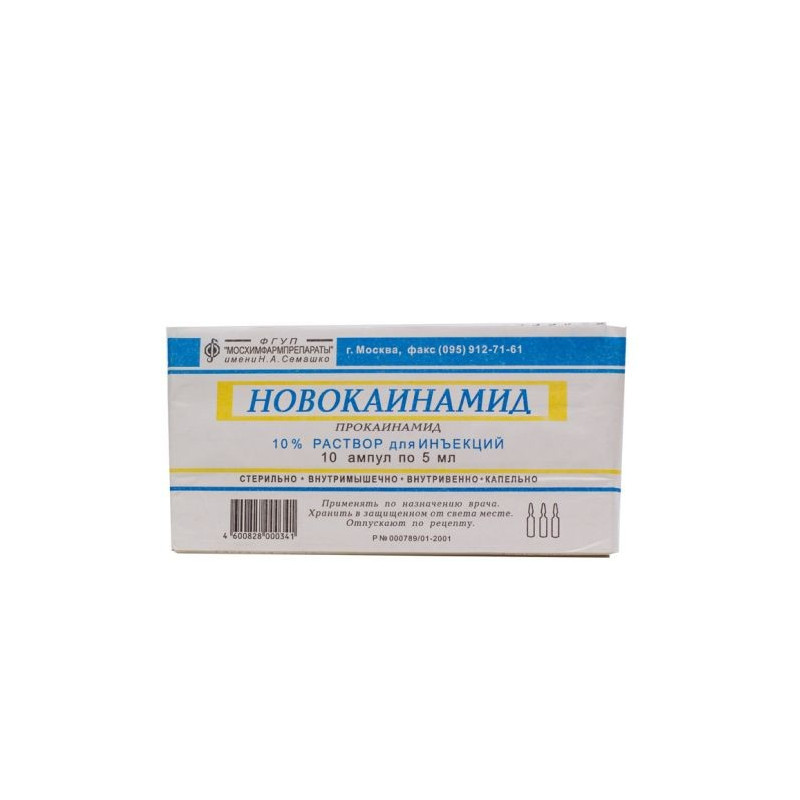



 All payments are encrypted via SSL
All payments are encrypted via SSL
 Full Refund if you haven't received your order
Full Refund if you haven't received your order
- ventricular arrhythmias;
- ventricular tachycardia;
- ventricular premature beats;
- atrial tachycardia;
- Atrial fibrillation and / or flutter.
In / in - 100-500 mg at a rate of 25-50 mg / min (under the control of blood pressure and ECG) to stopping paroxysm (maximum dose - 1 g) or in / in the drip - 500-600 mg in 25-30 minutes. Maintenance dose when on / in drip - 2-6 mg / min, if necessary, 3-4 hours after stopping the infusion, start taking the drug orally.
At heart failure II degree the dose is reduced by 1/3 and more.
V / m is administered in 5-10 ml (up to 20-30 ml / day).
With the on / in the introduction of the drug is diluted in 5% glucose solution or sodium chloride solution 0.9%. The rate of administration should not exceed 50 mg / min. At the same time, constant monitoring of heart rate, blood pressure and ECG is necessary.
Higher dose for adults with intramuscular and intravenous (drip) administration: single dose - 1 g (10 ml of the preparation), daily - 3 g (30 ml of the preparation).
When switching to the reception of the drug inside, the first dose is prescribed 3-4 hours after the termination of the IV infusion.
From the side of the central nervous system: general weakness, hallucinations, depression, myasthenia gravis, dizziness, headache, insomnia, convulsions, psychotic reactions with productive symptoms, ataxia.
Gastrointestinal: bitter taste in the mouth, diarrhea, nausea, vomiting.
Cardiovascular: decrease in blood pressure, ventricular paroxysmal tachycardia. With rapid on / in the introduction of possible development of collapse, a violation of atrial or intraventricular conduction, asystole.
Allergic reactions: skin rash.
- ventricular arrhythmia caused by intoxication with cardiac glycosides;
- sinoatrial and AV blockade of II and III degree (in the absence of implanted pacemaker);
- chronic heart failure in the stage of decompensation;
- arterial hypotension;
- cardiogenic shock;
- Systemic lupus erythematosus (including a history);
- ventricular tachycardias like "pirouette";
- extended QT interval;
- leukopenia;
- fluttering or ventricular fibrillation;
- lactation period;
- age up to 18 years (efficiency and safety have not been established);
- Hypersensitivity to the drug.
WITH caution
In connection with a possible reduction in myocardial contractility and a decrease in blood pressure, it is necessary to prescribe with great caution the drug for myocardial infarction. Perhaps arrhythmogenic effect.
Blockade of the bundle of His, AV block, I degree, myasthenia, bronchial asthma, hepatic and / or renal failure, chronic heart failure, ventricular tachycardia with coronary artery occlusion, surgical interventions (including surgical dentistry), marked atherosclerosis, elderly age.
Use during pregnancy and lactation
Use only when the benefit to the mother outweighs the potential risk to the fetus / child.
When prescribed during pregnancy there is a potential risk of arterial hypotension in the mother, which can lead to uteroplacental insufficiency.
Application for violations of the liver
WITH caution: liver failure.
Application for violations of kidney function
WITH caution: renal failure.
Contraindicated in children under 18 years.
Use in elderly patients
WITH caution elderly age. Elderly patients are more likely to develop arterial hypotension.
Before intravenous administration, it is necessary to dilute, enter at a rate not exceeding 50 mg / min; should be used only in a hospital setting.
During therapy, it is necessary to continuously monitor blood pressure, ECG, and peripheral blood formulas (at the end of therapy).
Elderly patients are more likely to develop arterial hypotension.
Symptoms: the drug has a low therapeutic breadth, therefore, severe intoxication can easily occur (especially with the simultaneous use of other antiarrhythmic drugs): bradycardia, sinoatrial and AV blockade, asystole, prolonged QT interval, paroxysm of polymorphic ventricular tachycardia, reduction of myocardial contractility, persistent arterial hypotension pulmonary edema, convulsions, coma, respiratory arrest.
Treatment: symptomatic. For the treatment of ventricular tachycardia, do not use antiarrhythmic drugs I A or 1 C classes. Sodium bicarbonate is able to eliminate the expansion of the QRS complex or arterial hypotension.
Enhances the effect of antiarrhythmic, antihypertensive, anticholinergic and cytostatic drugs, muscle relaxants, side effects of Bretilium tosylate.
With simultaneous use with antihistamine drugs, atropine-like effects may be enhanced; with pimozodom - prolongation of the QT interval.
Reduces the activity of anti-myasthenic drugs.
Cimetidine, Ranitidine reduce renal clearance of procainamide and lengthen T1/2.
In combination therapy with class III antiarrhythmic drugs, the risk of developing an arrhythmogenic effect increases.
Drugs that inhibit bone marrow hematopoiesis, increases the risk of myelosuppression.
Terms and conditions of storage
List B. Keep out of the reach of children, protected from light at a temperature of 0 to 25 ° C.
